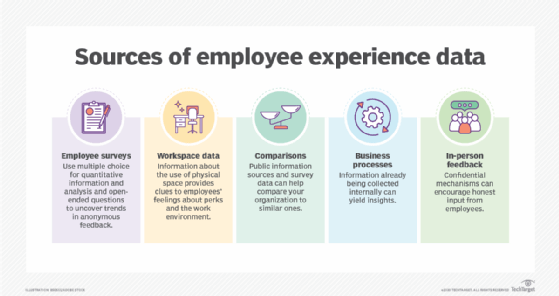Understand the emerging digital employee experience market (original) (raw)
The emerging market of digital employee experience is a very broad concept with many components and several major players touching different aspects of this process.

By
- Gabe Knuth,
- Enterprise Strategy Group
We provide market insights, research and advisory, and technical validations for tech buyers.
Published: 01 Feb 2023
Digital employee experience, or DEX, is an area of end-user computing that has been picking up steam for some time, and as an EUC lifer who has had his head down in the weeds for a while, I want to pay more attention to it.
The idea behind DEX is to ensure that employees enjoy a good experience, regardless of device or location, and that they remain engaged and productive. Organizations accomplish this through traditional monitoring techniques coupled with modern concepts, such as machine learning and AI-enabled automations, as well as qualitative capturing of employee sentiment.
Looking around this market, I see some familiar faces -- VMware, ControlUp, Lakeside and Ivanti -- but there are also companies such as Nexthink, 1E and Nanoheal, which are solely focused on DEX.
There are others, too. Tanium and Riverbed have DEX offerings, though they call it end-user experience management (EUEM). ThousandEyes, now a part of Cisco, focuses on browser-based application experience monitoring through synthetic testing. Even HP and, to a lesser extent, Dell are on board.
That list of companies is all over the place. Depending on who you're looking at, you think of unified endpoint management (UEM), traditional monitoring, networking, software management and PC hardware. So, how can they all be connected to DEX? It's actually quite simple: DEX is a huge, largely horizontal space that brushes up against many areas of the business.

What is DEX?
As I see it, DEX consists of three core tenets:
- performance monitoring of actual or synthetic users
- automated remediation
- qualitative assessments, user attestation and user sentiment
Monitoring
The need for performance monitoring as part of an overall DEX solution goes without saying, but anyone can monitor things and create pretty dashboards. Visualizing it is one thing, but taking action on it is the real power. That's why you see monitoring vendors such as ControlUp, Liquidware and Lakeside on the list. They've got a history of taking action using the data they collect. The rise of synthetic testing is also helping here by relying on AI and ML to identify issues and deviances from established baselines before users and admins do.
Automated remediation
IT administrators can identify many issues and remediate them before they cause widespread problems. While synthetic testing helps identify the problems, automating the remediations that are needed helps employees remain productive and lightens the load on IT resources.
Qualitative assessments
The last core piece of DEX is the qualitative assessments that measure what the user perceives the employee experience to be. In some cases, user experience doesn't match up with what's being observed via performance monitoring, so qualitative assessments -- such as surveys and chatbots -- are used to determine if, for example, a user is actually experiencing degraded performance. On the flip side, users could experience poor performance even though other metrics indicate everything should be fine.
These assessments can be done in lots of ways, from integrations with existing IT service management (ITSM) tools, such as ServiceNow, or built-in capabilities of a given DEX platform. There are also technologies that measure the end-user experience from their perspective. The data they collect is still quantitative by nature, but the goal is to measure from the perspective of the end user, not the perspective of the underlying systems.
DEX stretches across IT organizations and vendors
In the case of DEX, it's important to eliminate blind spots. Your monitoring needs to take into account data center, cloud, device, application and network components. This is the main reason you can see so many vendors from different walks of life staking their claims in this space. And while a few of them are trying to be all-in-one DEX platforms, the path may very well be for organizations to build a DEX strategy by implementing specialized products from many vendors and integrating them with each other.
Your monitoring needs to take into account data center, cloud, device, application and network components.
Take Liquidware, for example. Their offering is not considered a DEX platform despite having real-time metrics and remediation. They're missing the qualitive component but might be able to partner with, say, ServiceNow, to complete the picture.
Even hardware manufacturers are getting in on DEX, which is why you see HP and Dell ramping up their messaging. HP, for example, has HP Proactive Insights, which monitors devices and captures employee sentiment. It can automatically fix some issues and recommend other remediations to ITSM platforms through API integrations.
Finally, there are efforts to become one-stop shops. VMware Digital Employee Experience Management is positioned well, having the capabilities in Workspace One that work across traditional and mobile endpoints, such as UEM and Workspace One Intelligence. Also, Nanoheal, 1E and Nexthink are companies that are 100% dedicated to DEX from top to bottom.
Regardless of the vendors you use, DEX requires visibility into multiple areas in your organization. You'll need to account for physical and virtual desktops, endpoint devices -- including mobile -- networking, storage and even the app owners on the business side. Of course, that's nothing new to EUC; this has always been a horizontal endeavor.
Where do we go from here?
As I aim to understand this space more, I want to spend more time talking to vendors and customers to see exactly how they're using DEX platforms. With so much activity, surely some platforms are more tuned toward certain use cases, personas or customer types. Plus, I want to see if there's really such thing as a one-stop shop, or if DEX is more of a strategy built on integrated capabilities than an all-inclusive platform.
Regardless, the purpose of DEX is twofold:
- Reduce the load on ITSM resources by increasing automated remediations and self-service. This will reduce the number of calls to the help desk and have a trickle-down effect from there.
- Improve the end-user experience and stabilize it across all users and devices, regardless of app or location.
DEX should be a part of any EUC strategy, and the fact that it's gaining steam is evidence that organizations are prioritizing user experience. As I was told by VMware, "DEX is the pulse of a successful hybrid organization."
So that's the intro to DEX, at least as I've come to understand it. My plan is to start doing some research later this year after I work on my endpoint device preferences project. If you have any opinions, or if I've missed a concept or company, please let me know.
 How Toyota is transforming its digital employee experience
How Toyota is transforming its digital employee experience  By: Cliff Saran
By: Cliff Saran  NexDock 360: Flexible laptop alternative?
NexDock 360: Flexible laptop alternative?  Poor tech kills hybrid work productivity
Poor tech kills hybrid work productivity  Redefining DEX: Is user sentiment a requirement?
Redefining DEX: Is user sentiment a requirement?  By: Gabe Knuth
By: Gabe Knuth